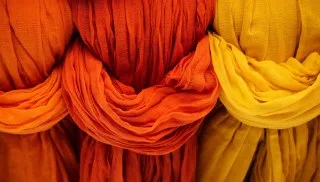The first known use of organic dyes dates back to 4000 years ago when indigo was found in the wrappings of mummies in Egyptian tombs. There are more than 100,000 commercially available dyes produced annually worldwide. These dyes are widely used in many industries such as textiles, food, cosmetics, and paper printing, the textile industry being the largest consumer of dyes. Textile industries now mainly use synthetic organic dyes such as direct dyes, process dyes, reactive dyes, etc.
The large variety of dyes and chemicals used in an attempt to produce more attractive popular shades of fabric for a competitive market makes it very complicated. In the past decade, environmental issues related to the production and application of dyes have increased significantly and are undisputedly among the main driving forces affecting the textile dye industry today. The term 'natural dyes' covers all dyes obtained from natural sources such as plants, animals, and minerals. Natural dyes are mostly unfixed and must be applied to textiles with a mordant, usually a metal salt, having an affinity for both the colorant and the fiber. Artificial dyes are widely used in a wide range of industries of which the textile processing industry is a major consumer.
Textile dyes
Textile dyes are chemicals that are used to impart a wide range of colors onto fabrics, yarns, and fibers. They have been in use for thousands of years, with evidence of their use dating back to ancient civilizations such as the Egyptians and Romans. Today, textile dyes play a crucial role in the fashion industry as they allow manufacturers to produce textiles with unique colors and patterns.
There are different types of textile dyes available on the market today. The most common categories include natural dyes, vat dyes, reactive dyes, acid dyes, disperse dyes, and many more. Natural dyes were derived from plant or animal sources while synthetic ones were produced in laboratories using chemical reactions.
One major concern related to textile dyeing is its impact on the environment. Most conventional synthetic dyeing processes involve high water consumption along with the release of harmful chemicals into wastewater streams which pollute rivers and affect aquatic life negatively. This has led some manufacturers to shift towards eco-friendly alternatives like natural dyestuff or bio-based coloring agents instead.
Another issue associated with textile dyeing is toxicity exposure for workers who handle these chemicals during manufacturing processes. Some components within conventional synthetic dye formulations can lead to toxic effects when exposed to skin contact or inhalation over prolonged periods leading to occupational health hazards, especially where protective measures aren't implemented effectively.
Despite these challenges posed by modern synthetic dyestuff production methods, research continues into new technologies aimed at reducing environmental impacts whilst improving product performance so that consumers can still enjoy clothing items made from beautiful traditional fabric designs but without sacrificing nature's well-being or worker safety/health aspects either.
Types of textile dyes
i. Azoic dyesii. Reactive dyes
iii. Vat dyes
iv. Sulphur dyes
v. Acid dyes
vi. Disperse dyes
vii. Basic dyes
viii. Direct dyes
Effect of textile dyes on the Environment
Textile dyes are widely used in the fashion industry to give fabrics their vibrant and appealing colors. However, these dyes can have a negative impact on the environment if not managed properly.
One of the most significant environmental impacts of textile dyeing is water pollution. Textile dyeing requires large amounts of water, which can be contaminated with chemicals and heavy metals from the dyeing process. These pollutants can then enter local waterways and harm aquatic life, as well as pose a risk to human health when consumed or used for irrigation.
Another issue is air pollution caused by volatile organic compounds (VOCs) released during the dyeing process. VOCs contribute to smog formation and air pollution that harms both humans and wildlife alike.
Furthermore, textiles that are dyed require more energy-intensive processing compared to undyed textiles since they have multiple color changes throughout their production cycle resulting in higher carbon emissions than undyed textiles.
The disposal of waste products from textile dyeing also poses a challenge for environmental management. Dye wastewater contains harmful chemicals such as benzene derivatives or intermediates like naphthols which may persist in soil over time causing long-term damage to ecosystems especially if not treated before being disposed into soils or oceans.
Solutions
There are potential solutions available today that could help mitigate some of these issues such as investing in cleaner technologies like non-toxic natural dyes made from plant-based sources; recycling wastewater through reuse instead dumping it into rivers and lakes; enforcing regulations around improved waste disposal practices linked with penalties for violating these standards at all levels - national down to local government bodies; educating consumers about sustainable fashion choices so they would value environmentally friendly alternatives over conventional ones among others.
Overall, considering appropriate measures towards environmentally conscious manufacturing methods could lead us towards resolving many challenges posed by textile dying processes while promoting responsible use within our ecosystem thereby protecting aquatic, land-based, and air species.









0 Comments